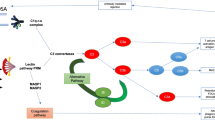Abstract
In pig-to-rabbit kidney xenograft (PRKX), endothelial antigen determinants (EAD) are immediately recognized by IgG and IgA, while IgM does not react with them. The purpose of this study was to investigate the different roles of IgG, IgA, IgM, and complement in the hyperacute rejection of a PRKX model. Nine isolated Landrace pig kidneys were each perfused withl0 ml normal New Zealand rabbit serum. Perfusates (serum A) were collected after discarding the first 0.5 ml. Serum A and rabbit complement were then incubated for 30 min with frozen sections of normal pig kidney. After washing with buffer solution all the specimens were treated for im-munohistochemistry. Three frozen sections of normal Landrace pig kidney and three samples of normal New Zealand rabbit serum were used as controls. Immunohis-tochemical analysis of the nine perfused kidneys demonstrated IgG, IgA and C3 deposition on the peritubular and glomerular vascular endothelium. No IgM reactivity was shown. In the frozen sections exposed to serum A, immunofluorescence showed minimal IgG, IgA and C3 reactivity while IgM deposition was clearly evident on the tubular epithelium. Immunofluorescence of frozen sections exposed to rabbit complement, done by fluorescein-labeled goat anti-rabbit C3 antibodies were positive only in the glomerular endothelium. The same rabbit complement was active in antibody dependent cytotoxicity on human T cells. Our results indicated that in the PRKX model, IgG and IgA acted as preformed antibodies recognizing endothelial EAD. IgM did not bind to any endothelial molecules, but recognized antigens located on the brush border of the tubular epithelium. Furthermore, in this model, absence of antigen-antibody complexes resulted in atypical complement deposition.
Access this chapter
Tax calculation will be finalised at checkout
Purchases are for personal use only
Similar content being viewed by others
References
Auchincloss H (1988) Xenogeneic transplantation. Transplantation 46:1–20
Calne RY (1970) Organ transplantation between widely disparate species. Transplant Proc 2:550–553
Cooper DKC, Kemp E, Reemtsma K, White DJG (1991) Xenotransplantation. Springer-Verlag, New York, NY
Fischel RJ, Bolman RM III, Piatt JL, Najarian JS, Bach FH, Matas AJ (1990) Removal of IgM anti-endothelial antibodies results in prolonged cardiac xenograft survival. Transplant Proc 22: 1077–1078
Gambiez L, Weill BJ, Chereau CH, Calmus Y, Houssin D (1990) The hyperacute rejection of guinea pig to rat heart xenografts is mediated by preformed IgM. Transplant Proc 22:1058
Kissmeyer-Nielson F, Olsen S, Peterson VP, Fjeldborg O (1966) Hyperacute rejection of kidney allografts associated with pre-existing humoral antibodies against donor cells. Lancet 2: 662–665
Marino IR, Ferla G, Celli S, Stieber A, Muttillo I, Maggiano N, Mazzaferro V, Perrelli L, Musiani P (1990) Hyperacute rejection in renal discordant xenograft (pig-to-rabbit): model assessment and rejection mechanisms. Transplant Proc 22:1071–1076
Marino IR, Ferla G, Celli S, Stieber A, Muttillo I, Maggiano N, Perrelli L, Musiani P (1991) In vivo and in vitro study of hyperacute rejection mechanism of renal discordant xenograft. Transplant Proc 23:620–622
Marino IR, Celli S, Ferla G, Stieber A, Maggiano N, Musiani P (1991) Histopathological, immunofluorescent and electromicro-scopical features of hyperacute rejection in discordant xenotransplantation. In: Cooper DKC, Kemp E, Reemtsma K, White DJG (eds) Xenotransplantation. Springer-Verlag, New York
Starzl TE (1964) Experience in Renal Transplantation. Saunders, Philadelphia
Starzl TE (1969) Experience in Hepatic Transplantation. Saunders, Philadelphia
Starzl TE, Iwatsuki S, Thiel DH van, Gartner JC, Zitelli BJ, Ma-latack JJ, Schade RR, Shaw BJ Jr, Hakala TR, Rosenthal JJ, Porter KA (1982) Evolution of liver transplantation. Hepatology 2: 614–636
Terasaki PI (1990) Clinical Transplants. UCLA Tissue Typing Laboratory, Los Angeles
Author information
Authors and Affiliations
Editor information
Editors and Affiliations
Rights and permissions
Copyright information
© 1992 Springer-Verlag Berlin Heidelberg
About this paper
Cite this paper
Marino, I.R. et al. (1992). Antibody binding to endothelial and epithelial antigens triggers pig-to-rabbit xenograft rejection and its absence results in atypical complement deposition. In: Kootstra, G., Opelz, G., Buurman, W.A., van Hooff, J.P., MacMaster, P., Wallwork, J. (eds) Transplant International Official Journal of the European Society for Organ Transplantation. Springer, Berlin, Heidelberg. https://doi.org/10.1007/978-3-642-77423-2_99
Download citation
DOI: https://doi.org/10.1007/978-3-642-77423-2_99
Publisher Name: Springer, Berlin, Heidelberg
Print ISBN: 978-3-540-55342-7
Online ISBN: 978-3-642-77423-2
eBook Packages: Springer Book Archive




